Dark Water Megs - How To Value A Megalodon Tooth
Are fossil shark teeth expensive?
Why are some megalodon teeth worth more than others?
A question I get all the time is "how much is this megalodon tooth worth?"
I am going to attempt to answer this question by outlining the major factors that go into putting a valuation on a megalodon tooth or other fossilized shark tooth.
Size
Arguably the most important factor when it comes to fossilized shark teeth is size. There are several reasons why size is such a relevant factor when trying to put a value on a shark tooth. The larger a shark tooth generally the larger the shark it came from. As far as collecting goes most people would rather have a an item from a shark than a smaller one.
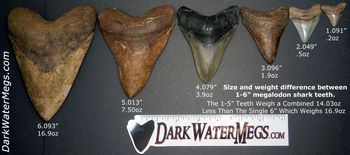 There are far more small shark teeth than large shark teeth. All sharks, not matter what the species started out small, some of them made it to adolescence, some did not, some made it to adulthood and even more did not, what percentage of the population made it to the maximum size possible we don't know for sure. But think of it this way, if humans continued to grow past puberty and just kept getting bigger the older they got by age 100 they might be 20' tall. But what percentage of the population lives to be 100? Also consider that humans have an extremely low mortality rate. Consider the same example with American Alligators who have a moderately high mortality rate, it is very common to see young and juvenile alligators under 5', as they get larger they become fewer in number, large alligators over 10' are considered uncommon and very large alligators over 12' in size are considered rare. However; there have been gators caught over 15' in length but are considered extremely rare. So considering that the megalodon
There are far more small shark teeth than large shark teeth. All sharks, not matter what the species started out small, some of them made it to adolescence, some did not, some made it to adulthood and even more did not, what percentage of the population made it to the maximum size possible we don't know for sure. But think of it this way, if humans continued to grow past puberty and just kept getting bigger the older they got by age 100 they might be 20' tall. But what percentage of the population lives to be 100? Also consider that humans have an extremely low mortality rate. Consider the same example with American Alligators who have a moderately high mortality rate, it is very common to see young and juvenile alligators under 5', as they get larger they become fewer in number, large alligators over 10' are considered uncommon and very large alligators over 12' in size are considered rare. However; there have been gators caught over 15' in length but are considered extremely rare. So considering that the megalodon  shark would have had a fairly high mortality rate considering how violent the ancient seas were based on the fossil record one could conclude that there were many megalodons under 20' but megalodons over 40 feet would be uncommon, and megalodons over 50' would be very rare. Not only were there far more small megalodons than big ones but the big ones lost their teeth throughout their entire life, producing only the large teeth that are now so coveted towards the end of their lives.
shark would have had a fairly high mortality rate considering how violent the ancient seas were based on the fossil record one could conclude that there were many megalodons under 20' but megalodons over 40 feet would be uncommon, and megalodons over 50' would be very rare. Not only were there far more small megalodons than big ones but the big ones lost their teeth throughout their entire life, producing only the large teeth that are now so coveted towards the end of their lives.
People also gravitate towards larger megalodon and other fossil shark teeth not just because of their rarity but because of the stark contrast with modern teeth. Any fossil shark tooth that is over 3" represents an animal that is far bigger than any shark swimming in the oceans today.
Bigger is better, not always the case but most people purchase megalodon teeth as a collector's item that will be displayed and looked at. While a 1" fossil mako tooth is a historical item millions of years old that deserves admiration, it often does not get the "WOW" factor that a 3-5" megalodon of the same time period would get.
The big ones like to break. Because of their sheer size large shark teeth often have a tendency to break. Add in the fact that they have 3-20 million years to wash into a rock, have something dropped on them, etc it is easy to see why the vast majority of megalodon teeth found are broken. The larger size in some situations can also make them more susceptible to breaking. If you drop a marble onto your driveway it will likely bounce and be alright, if you were to drop a 40lb glass sphere it would like break. Or if you were to drive your car over a thin 4'x4' rock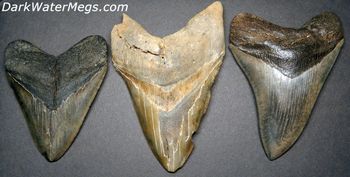 it would likely shatter, where if you drove your car onto a gravel driveway the small individual rocks would not likely break.
it would likely shatter, where if you drove your car onto a gravel driveway the small individual rocks would not likely break.
Condition
The condition of a megalodon tooth or other fossilized shark tooth is key in determining valuation. If the tooth has serrations present, good enamel, and intact root it will fetch a higher price than an identical tooth that was broken in half and heavily tumbled in the water.
Teeth in good condition are significantly more rare than broken teeth. This is due to a few factors.
First these teeth were not originally designed to be put on a shelf and look nice, they were in the mouth of the world's greatest predator. The megaldon's teeth would regularly come in contact with whale bone, some of the fossil whale bone that I have personally found is over 1' thick, combine that with the jaws of the megalodon closing with over 10 tons of force and you have a recipe for shattered teeth.
Next you have to consider the amount of time that has passed since the tooth fell out of the sharks mouth, a lot of tectonic activity, super storms, etc have happened in the past 10 million years, for these teeth to be preserved at all is somewhat of a miracle, ones that are intact are even more rare.
Finally the teeth that are currently being found are often in violent environments when they are exposed out of sediment layer they have laid in fossilized formillions of years. A few examples are the few teeth that are uncovered by mining operations, these teeth are being exposed by extremely large machinery trying to efficiently access the minerals and ore in the ground and most of the teeth don't stand a chance. Many teeth are also found in rivers, many of these rivers have swift current that moves and gravel, constantly chipping and eroding these teeth.
In my opinion there is no such thing as a perfect megalodon tooth, each one will have some wear, a chipped serration, enamel cracking, root pitting, or some other flaw. At the same time I think it is ridiculous to look at something that came out of an apex predator millions of years ago and not be inspired and amazed.

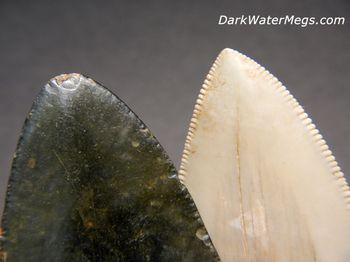

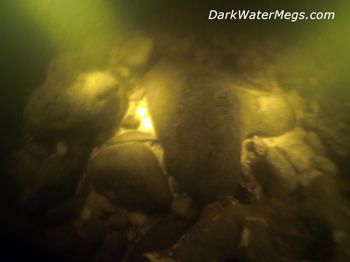
Location
Teeth from certain locations bring a higher price than others. Location value is usually tied to rarity.
Some locations are difficult or impossible to get to, teeth that have previously been collected from these locations can command a higher price as the location may become closed or inaccessible for shark tooth hunters for some time, or forever.
For instance some years ago some megalodon teeth were dredged up from the Pacific ocean from over 1000' under water, due to the expense to do this and new environmental standards it is likely that the remaining teeth in that location will stay on the bottom of the ocean.
Another example are the phosphate mines in central Florida. At one point these mines allowed collectors to enter the mines during weekends and periods that the mines were shut down to collect fossils. Due to fear of lawsuits and an increasing liability avoiding culture that access has been significantly reduced.
Fossils from the deep Pacific ocean or Florida phosphate mines can command a higher price in some situations than areas where fossil collection is still relatively easy and the teeth are abundant.
The phosphate mines in Morocco, specifically the Khouribga region are rich with fossil shark teeth. The heavy mining equipment exposes them and because much of the surrounding area is experiencing economic hardship the fossil teeth are gathered in vast 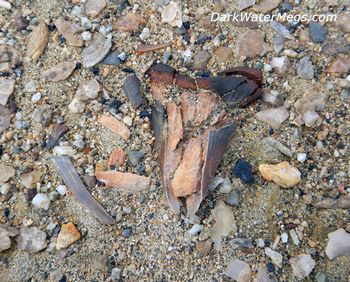 quantities to be sold in the US, Europe, and other countries who have citizens with disposable income.
quantities to be sold in the US, Europe, and other countries who have citizens with disposable income.
Location can be a factor as it usually correlates to the rarity of the teeth themselves, for instance the Pacific dredge teeth are generally more expensive than the Moroccan mine teeth, simply because the Pacific teeth are no longer readily available and the Moroccan teeth are being recovered by the tens of thousands.
Difficulty of recovery can also play a part in value, some areas of the world shark teeth are easier to find. Some areas they can be found simply by walking in fields after rain or walking through shallow creeks, others have to be recovered using specialized equipment, scuba diving, or other costly or dangerous recovery method.
A rock from your driveway is worth significantly less than a rock brought back from the moon, one was recovered very easily with almost no expense, the other cost a significant amount both in money and risk to the people recovering it. For that reason shark teeth found in dangerous locations such as dark water rivers often command a higher price than beach found teeth, etc.
Color
Shark teeth all came out of the shark's mouth the same color, like modern sharks they would have been white in color. The colors of shark teeth we find todaywere imparted on the tooth via different mineral compositions during the fossilization process. The mineral composition of the ocean bottom the shark tooth landed in and remained in throughout it's existence determined the color of the tooth and if it was fossilized or simply decomposed.
Color plays a significant role in value for a couple of reasons. Some colors are more rare than others, from Morocco the light tan color teeth are extremely common and from the US a large portion of the teeth are grey and black. The more rare colors: red, blue, green, brown, etc. can command a higher price simply because 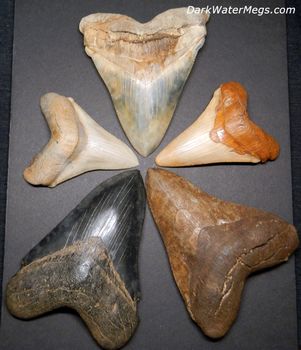 they are more rare than the average grey or black teeth from the US or the common tan color teeth from Morocco.
they are more rare than the average grey or black teeth from the US or the common tan color teeth from Morocco.
Besides rarity color can make some teeth more attractive than others, some of this is personal preference but some colors have more general appeal than others.
Species
Some sharks teeth species are more common than others, factors that contribute to the rarity of a species of shark tooth found include historical time period, number of sharks, rate of tooth loss, etc.
Some shark teeth from rare species like the Parotodus benedini are considerably more rare than say the lemon shark tooth.
Repair, Restoration, and Stretching
All of the factors above play a key role in putting a value on a tooth. Unfortunately most of those factors can be altered or modified. Tooth restoration is the process of repairing a tooth, enhancing, or enlarging a tooth beyond how it was found.
For instance a tooth with significant enamel issues can be repaired so it looks almost perfect. A tooth could have a broken root or tip and be repaired back to what the restorer assumes the tooth would have looked like.
Tooth stretching is when a tooth restorer repairs a broken portion of a shark tooth and adds extra repair material to increase the overall size of the tooth. Sometimes the restorer will make an educated guess and try to return the tooth to it's original condition, and sometimes the restorer will stretch the tooth to achieve a desired size.
I personally do not repair or restore any of my teeth, I personally would have a damaged tooth in it's natural state than a seemingly perfect tooth that was restored and stretched. Everyone has their own opinion on tooth restoration. The teeth I sell have not been restored, if the buyer chooses to restore the their teeth it is their right to do so.
One problem that arises when buying teeth is the question of their authenticity, in my opinion the value of a tooth goes down each time it changes hands. Each time a tooth transfers between someone other than the person that found it and the initial buyer the authenticity of the tooth becomes more difficult. If you purchase a tooth from someone that had previously been bought and sold several times it is very difficult to know if the tooth has had restoration. If you purchase it from the person who initially found the tooth you can determine if it was restored or was in it's natural state. The more times a tooth changes hands the more opportunities for repair and restoration.
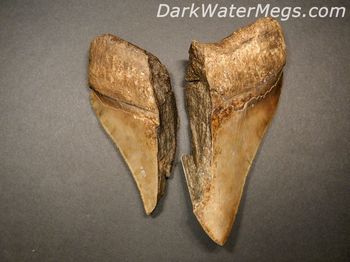
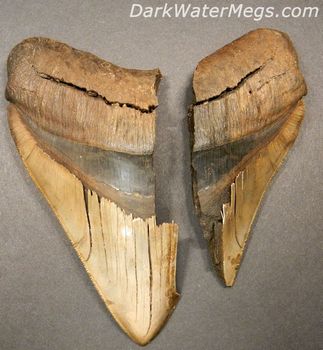
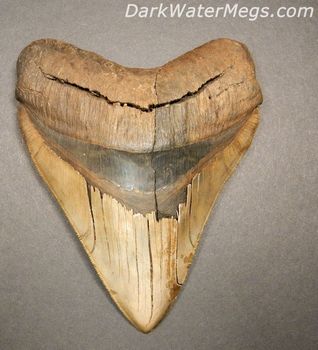
In Conclusion
These fossilized teeth are one of a kind items, there are similar teeth that can be used as comparisons but there are truly no two that are exactly alike. Some would argue that these fossilized teeth from ancient sharks that are millions of years old are nothing more than a useless rock and have zero value. Others might say that each one is a fantastic piece of our history and is priceless. I believe that each tooth out there lies somewhere in between those two valuations and the tooth is worth one person is willing to sell it for and another is willing to buy it for.
My advice is to purchase a tooth that you like, get one that is large enough and has the right color and condition for you to enjoy it, make sure if the tooth has been restored you are aware of that, at peace with it being restored, and the tooth has been priced accordingly. To ensure your tooth has not been restored without being disclosed as such I recommend you purchase the tooth from the person who found it if at all possible.
